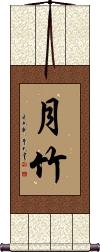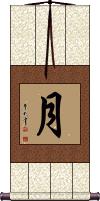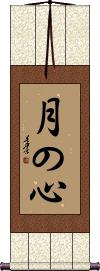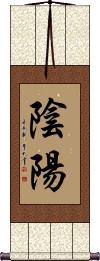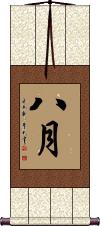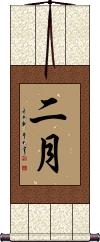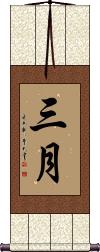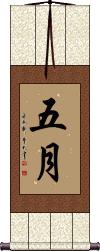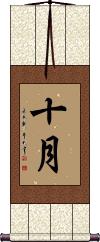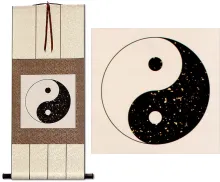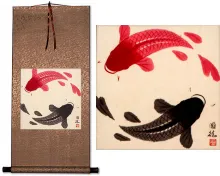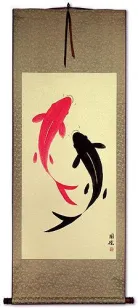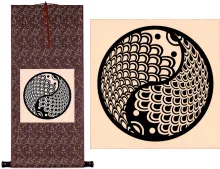Buy a Moon Chinese/Japanese Calligraphy Wall Scroll
We have many options to create artwork with the Chinese characters / Asian symbols / Japanese Kanji for Moon on a wall scroll or portrait.
1. Bamboo Moon
2. Moon
3. Moonlight
4. New Moon
7. Tsuki no Kokoro / Mind like the Moon
8. Flower in the Mirror, Moon on Water
9. Yin Yang
10. April
11. August
12. February
13. July
14. June
15. Month of March
16. The Month of May
17. October
Bamboo Moon
月竹 is the title, “Bamboo Moon” - Technically, it's in the order of “moon bamboo,” but that's the most natural order in Chinese and Japanese.
With a little research, I found this title has been used as the name of a linen company, a band, a song title, an actual person's name, the title for a piece of artwork featuring bamboo with a moon in the background, and a few other things. I added it here because many people searched for “bamboo moon” on my website, so here it is for you.
The typical Japanese pronunciation would probably be "tsu-ki ta-ke." However, this would not be the only possible pronunciation in Japanese (especially if used as a given name).
Moon
月 is how to write the title for “moon” in Chinese, Korean Hanja, and Japanese Kanji.
月 is also used to refer to the month. This is because China traditionally uses a lunar calendar, so saying “next moon” is the same as saying “next month” etc.
In modern Chinese and Japanese and old Korean, the character for a number is put in front of this moon character to represent western months. So “one moon” is January “two moons” is February etc.
If you are wondering, in the east Asian way to write dates, the character for “sun” or “day” is used with a number in front of it to express the day of the month. So “ten moons, one sun” becomes “October 1st” or “10/1” (this date happens to be Chinese National Day - The equivalent of Independence Day in the USA, Canada Day, or the Queen's Birthday).
In Japanese, 月 can be a surname that romanizes as Tsuki, Tsukizaki, or Takagetsu.
Moonlight
月光 is the Chinese, old Korean Hanja, and Japanese Kanji title for moonlight.
This can also be used to describe a moonbeam and can be a given name in all three languages (pronounced as Rumi when used as a female given name in Japanese).
New Moon
The Sun, Moon, and Stars
日月星辰 is a title that encompasses all of the heavenly bodies or celestial bodies.
Namely, this includes the Sun, Moon, and Stars of our universe.
Sun Moon Stars
Tsuki no Kokoro / Mind like the Moon
Flower in the Mirror, Moon on Water
鏡花水月 is an old Asian proverb that means “flowers in a mirror and the moon reflected in the lake” or “flowers reflected on a mirror and the moon reflected on the water's surface.”
Literally, 鏡花水月 reads “Mirror Flower, Water Moon.”
Figuratively this can be used to represent a lot of different ideas. It can be used to express an unrealistic rosy view or viewing things through rose-tinted spectacles. So you can use it to relay an idea about something that is visible but has no substance,
something that can be seen but not touched, or something beautiful but unattainable such as dreams or a mirage.
This expression is used to describe things like the subtle and profound beauty of poems that cannot be described in words.
鏡 = Mirror (or lens)
花 = Flower(s)
水 = Water
月 = Moon
Can also be written 水月鏡花 (just a slight change in word/character order).
Yin Yang
陰陽 literally means yin and yang in written form (versus the common yin-yang symbol). The first character has the element of the moon, while the second character has the element of the sun so that you can see, even in written form, they suggest the balance of opposites (of night and day). You could also translate this title as “sun and moon.”
Note: This title is often misspelled as Ying Yang instead of Yin Yang.
See Also: Taoism
April
Fourth Month
This is April in Chinese, Japanese Kanji, and old Korean Hanja.
This was originally the fourth month of the Chinese lunar year, now used for the fourth month of the Gregorian calendar (also known as the Western or Christian calendar). 四月 literally mean “fourth month” or “fourth moon.”
August
Eighth Month
八月 is the month of August in Chinese, Japanese Kanji, and old Korean Hanja.
八月 literally means “eighth month” or “eighth moon.”
In Japanese, this can also be the female given name, Yatsuki, in much the same way August can be a female given name in English.
February
二月 is the Chinese, Japanese Kanji, and old Korean Hanja for the month of February.
This literally means the “second month” or “second moon” (of the year).
July
Seventh Month
七月 is how Chinese and Japanese express July (also used in old Korean Hanja).
七月 literally means “seventh month” or “seventh moon.”
June
Sixth Month
This is the month of June in Chinese, Japanese Kanji, and old Korean Hanja.
This was originally the sixth month of the Chinese lunar year, now used for the sixth month of the Gregorian calendar (also known as the Western or Christian calendar). 六月 literally mean “sixth month” or “sixth moon.”
Month of March
Third Month of the Year
三月 is the Chinese, Japanese, and Chinese way to write the month of March.
This literally reads as “third month” or “third moon.”
The Month of May
Fifth Month
五月 is the month of May in Chinese, Japanese Kanji, and old Korean Hanja.
This was originally the fifth month of the Chinese lunar year, now used for the fifth month of the Gregorian calendar (also known as the Western or Christian calendar). 五月 literally means “fifth month” or “fifth moon.”
Note: Sometimes Japanese parents will use this as a female given name, and use "Mei" (the sound of May in English) as the pronunciation.
October
Tenth Month
十月 is how Chinese and Japanese express October (also used in old Korean Hanja).
十月 literally means “tenth month” or “tenth moon.”
Great Expectations
望 holds the ideas of ambition, hope, desire, aspiring to, expectations, looking towards, to gaze (into the distance), and in some contexts, full moon rising.
望 is one of those single characters that is vague but in that vagueness, it also means many things.
望 is a whole word in Chinese and old Korean but is seldom seen alone in Japanese. Still, it holds the meanings noted above in all three languages.
This in-stock artwork might be what you are looking for, and ships right away...
The following table may be helpful for those studying Chinese or Japanese...
| Title | Characters | Romaji (Romanized Japanese) | Various forms of Romanized Chinese | |
| Bamboo Moon | 月竹 | tsuki take / tsukitake | yuè zhú / yue4 zhu2 / yue zhu / yuezhu | yüeh chu / yüehchu |
| Moon | 月 | tsuki | yuè / yue4 / yue | yüeh |
| Moonlight | 月光 | gekkou / geko | yuè guāng yue4 guang1 yue guang yueguang | yüeh kuang yüehkuang |
| New Moon | 新月 | shingetsu | xīn yuè / xin1 yue4 / xin yue / xinyue | hsin yüeh / hsinyüeh |
| The Sun, Moon, and Stars | 日月星辰 | nichigetsuseishin | rì yuè xīng chén ri4 yue4 xing1 chen2 ri yue xing chen riyuexingchen | jih yüeh hsing ch`en jihyüehhsingchen jih yüeh hsing chen |
| Sun Moon Stars | 日月星 | nichigetsusei | rì yuè xīng ri4 yue4 xing1 ri yue xing riyuexing | jih yüeh hsing jihyüehhsing |
| Tsuki no Kokoro Mind like the Moon | 月の心 | tsuki no kokoro tsukinokokoro | ||
| Flower in the Mirror, Moon on Water | 鏡花水月 镜花水月 | kyou ka sui getsu kyoukasuigetsu kyo ka sui getsu | jìng huā shuǐ yuè jing4 hua1 shui3 yue4 jing hua shui yue jinghuashuiyue | ching hua shui yüeh chinghuashuiyüeh |
| Yin Yang | 陰陽 阴阳 | in you / inyou / in yo | yīn yáng / yin1 yang2 / yin yang / yinyang | |
| April | 四月 | shi gatsu / shigatsu | sì yuè / si4 yue4 / si yue / siyue | ssu yüeh / ssuyüeh |
| August | 八月 | hachigatsu / yatsuki | bā yuè / ba1 yue4 / ba yue / bayue | pa yüeh / payüeh |
| February | 二月 | futatsuki / nigatsu | èr yuè / er4 yue4 / er yue / eryue | erh yüeh / erhyüeh |
| July | 七月 | shichigatsu | qī yuè / qi1 yue4 / qi yue / qiyue | ch`i yüeh / chiyüeh / chi yüeh |
| June | 六月 | roku gatsu / rokugatsu | liù yuè / liu4 yue4 / liu yue / liuyue | liu yüeh / liuyüeh |
| Month of March | 三月 | mitsuki / sangatsu | sān yuè / san1 yue4 / san yue / sanyue | san yüeh / sanyüeh |
| The Month of May | 五月 | satsuki / go gatsu satsuki / gogatsu | wǔ yuè / wu3 yue4 / wu yue / wuyue | wu yüeh / wuyüeh |
| October | 十月 | juu gatsu / juugatsu / ju gatsu | shí yuè / shi2 yue4 / shi yue / shiyue | shih yüeh / shihyüeh |
| Great Expectations | 望 | bou / nozomi bo / nozomi | wàng / wang4 / wang | |
| In some entries above you will see that characters have different versions above and below a line. In these cases, the characters above the line are Traditional Chinese, while the ones below are Simplified Chinese. | ||||
